A complete listing of currently available online programs is provided below. To access course materials click an available viewing format provided with each listing (PDF, HTML5, Webinar). To access online exams and claim credit, courses must be selected and added to your Guerbet CE User Record. In order to view course content you must be registered and logged in.
Advanced MRI Safety Training For Healthcare Professionals (4th Edition) Level 2 MR Personnel
Faculty:
Frank G. Shellock, PhD, FACC, FACR, FACSM
Expiration Date: April 30, 2026
CE Credit Hours:
3.0
Tuition:
No Charge
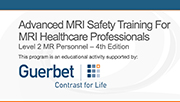
This program reviews fundamental MRI safety information and meets the annual training recommendations from the American College of Radiology. Importantly, MRI facilities must now comply with the revised requirements for diagnostic imaging from The Joint Commission and document that MRI technologists participate in ongoing education that includes annual training on safe MRI practices in the MRI environment. Notably, Advanced MRI Safety Training for Healthcare Professionals, Level 2 MR Personnel covers each MRI safety topic specified by The Joint Commission, as well as many additional subjects that will expand the knowledge-base of healthcare professionals involved with MRI technology.
With 35 years of experience in the field of MRI, the author of the best-selling textbook series, the Reference Manual for Magnetic Resonance Safety, Implants and Devices, and the creator of the internationally popular website, MRIsafety.com, Dr. Frank G. Shellock is uniquely qualified to present the information in this program.
Advanced MRI Safety Training for Healthcare Professionals (4th Edition), Level 2 MR Personnel is a 2 hour and 45 minute program that is divided into three different sections.
Educational Objectives
-
Understand the safety issues related to MRI.
-
Describe the bioeffects associated with the static magnetic field, time-varying magnetic fields, and radiofrequency fields.
-
Present guidelines that prevent projectile-related accidents.
-
Describe polices that avoid issues related to acoustic noise.
-
Review procedures that prevent burns associated with MRI.
-
Explain and demonstrate appropriate pre-MRI screening procedures.
-
Identify techniques to manage patients with claustrophobia, anxiety, or emotional distress.
-
Describe guidelines to handle medical emergencies in the MRI setting.
-
Understand the safety considerations for gadolinium-based contrast agents.
|
Body MRI with Gadopiclenol
Faculty:
Bachir Taouli, MD MHA
Expiration Date: February 29, 2028
CE Credit Hours:
1.0
Tuition:
No Charge
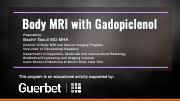
While gadolinium-based contrast agents (GBCAs) are essential to performing MR imaging, guidance from the US Food and Drug Administration (FDA) and the American College of Radiology (ACR) includes the recommendation of limiting a patient's gadolinium exposure. One technique for reducing gadolinium exposure is to use a high-relaxivity gadolinium-based contrast agent (GBCA) that can be administered at a lower dose than a conventional GBCA without negatively impacting image quality. Gadopiclenol is an FDA-approved, macrocyclic, high relaxivity GBCA that reveals high-quality images at half the conventional dose of other GBCAs and is approved for body MRI applications.
This educational program provides the clinical rationale for adopting the use of Gadopiclenol for Body MRI.
Through case study reviews, Bachir Taouli MD, will share clinical insights to achieve optimal image quality using a lower administered gadolinium dose during body MRI. A focus on the safety, selection and utilization of a high relaxivity, lower dose GBCA will be supported by clinical evidence and imaging protocols. Audience participation will be encouraged during the Q & A session following the presentation.
Educational Objectives:
At the completion of this activity, participants should be able to:
-
State the properties of the FDA-approved GBCAs (gadolinium-based contrast agents).
-
Understand the clinical risks and safety considerations of GBCA selection and utilization.
-
Implement the use of Gadopiclenol in Body MRI applications.
This program is an educational activity sponsored by Guerbet, LLC.
|
Breast MRI with Gadopiclenol
Faculty:
Katja Pinker-Domenig, MD, PhD, EBBI, FISMRM, FSBI
Expiration Date: July 31, 2027
CE Credit Hours:
1.0
Tuition:
No Charge
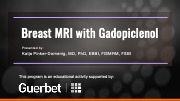
Dynamic contrast-enhanced breast MR imaging using gadolinium-based contrast agents (GBCAs) offers superior cancer detection to mammography and breast ultrasound due to the visualization of tumor neovascularity as a tumor-specific feature. Despite the clear advantages of breast MR imaging, it is currently recommended only for patients with a high lifetime risk of breast cancer, but recent data shows that there is also a benefit for women at a greater than average risk
While GBCAs are essential to performing breast MR imaging, guidance from the US Food and Drug Administration (FDA) and the American College of Radiology (ACR) includes the recommendation of limiting a patient's gadolinium exposure where possible. One technique for reducing gadolinium exposure is to use a high-relaxivity GBCA that can be administered at a lower dose than a conventional GBCA without deteriorating image quality. Gadopiclenol recently received FDA approval and is a high-relaxivity GBCA that decreases gadolinium exposure.
This educational program provides a clinical rationale for lowering the administered gadolinium dose when performing breast MRI on patients who may receive repeat MR contrasted exams throughout their lifetime for breast cancer screening. Through a review of case studies, Dr. Pinker-Domenig will provide insight on how to achieve optimal imaging while lowering the gadolinium dose with Gadopiclenol for breast MRI.
Educational Objectives:
At the completion of this activity, participants should be able to:
-
Understand and employ the clinical indications for dynamic-contrast enhanced breast MRI.
-
Access clinical considerations and apply lower gadolinium dosing options for patients who may experience repeat, lifetime dosing of a GBCA for breast MRI.
-
Implement breast MR imaging protocols to achieve the most accurate breast cancer diagnosis.
This program is an educational activity sponsored by Guerbet, LLC.
|
Clinical Applications & Imaging Considerations of Gadopiclenol Injection
Faculty:
Lawrence N. Tanenbaum, MD, FACR | Applied Radiology
Expiration Date: May 31, 2026
CE Credit Hours:
1.0
Tuition:
No Charge

In September 2022, Gadopiclenol injection, which is both macrocyclic (stable) and has high relaxivity properties received FDA marketing approval and may provide dosing options that can decrease gadolinium exposure, particularly in vulnerable patients.
In this accredited webinar, the assessment of Gadopiclenol injection in neuro, body, and pediatric MR imaging will be presented by a panel of MR imaging experts and will include commentary from Lawrence N. Tanenbaum, MD. To encourage audience participation, a live Q & A session will follow the discussion.
Educational Objectives:
At the completion of this activity, participants should be able to:
-
Explain the properties that distinguish Gadopiclenol injection from the other high-relaxivity and conventional gadolinium-based contrast agents.
-
Describe the clinical use of Gadopiclenol injection in neuro, body, and pediatric MRI applications.
-
Describe the clinical development program of Gadopiclenol injection for neuro and body MRI applications.
-
Apply clinical considerations and dosing options when selecting a macrocyclic, high relaxivity, MRI contrast in vulnerable patient populations.
Approved by the AHRA for Category A ARRT continuing education credit
This webinar is an educational activity sponsored by Guerbet, LLC.
|
Clinical Applications of MR Imaging in Stereotactic Localization Radiosurgery Procedures
Faculty:
Glen Stevens, DO, PhD | Jenny Wu
Expiration Date: January 31, 2027
CE Credit Hours:
1.5
Tuition:
No Charge
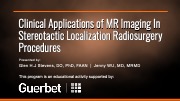
Gadolinium-based contrast agents (GBCAs) are essential for enhancing the quality of MRI scans to make it easier for radiologists to identify pathology. The US Food and Drug Administration (FDA) and the American College of Radiology (ACR) recommend limiting patient exposure to gadolinium where possible.
One technique for reducing this exposure is to use a high relaxivity GBCA that can be administered at a lower dose than a conventional GBCA, without any impact on image quality. GBCA selection for interventional procedures such as radiosurgery is one such example, where the selection of a GBCA can play a role in patient management and outcomes.
In this program, an experienced neuroradiologist and neuro oncologist will present their clinical experiences with the use of stereotactic localization radiosurgery, following the administration of a high relaxivity GBCA. Through case study examples, the clinical impact of contrast selection will be demonstrated. Following the presentation, questions from the audience were addressed during a live Q&A session.
Educational Objectives:
At the completion of this activity, participants should be able to:
-
Review the role of stereotactic radiosurgery (SRS) for brain metastases and the role of pre-operative localization MRI exams for stereotactic radiosurgery.
-
Outline the differences between gadopiclenol and other group II gadolinium-based contrast agents.
-
Discuss the use of gadopiclenol in specific case-based scenarios for stereotactic localization exams and its impact on patient management.
|
Contrast Safety – Review of Radiologic Contrast Media
Faculty:
Vanessa L. Lewis Williams, MD
Expiration Date: May 31, 2027
CE Credit Hours:
1.0
Tuition:
No Charge
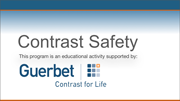
The administration of contrast agents is an essential part of many diagnostic imaging procedures. The use of such agents can dramatically improve the visibility and characterization of many pathological issues.
Knowledge, familiarity, and practice are crucial for an appropriate and effective use of contrast and the response to adverse events when they occur. Therefore, it is vital for radiologists to understand the agents they inject, the contra-indications for injection, and any potential associated risks, in order to act and react accordingly in a timely manner.
Furthermore, the spread of infections through the use of contrast has also been a growing concern. Costly medications and severe drug shortages have encouraged the inappropriate reuse of single-dose vials which has led to serious and fatal infections. A thorough understanding of infection control best practices is needed to ensure the safety of patients undergoing diagnostic imaging.
Educational Objectives
-
Review the major categories of contrast
-
Identify FDA-approved gadolinium-based contrast agents and their mechanisms of action
-
Review the evidence describing gadolinium retention in the body
-
Evaluate the safety of gadolinium-based contrast to determine the risk/benefit in an individual patient
-
Apply recent guidelines and recommendations for the management of patients who require the use of Contrast
-
Describe the critical need for infection control when administering contrast
-
Discuss the recommendations and benefits of single-dose vials and prefilled syringes in reducing infections
-
Know appropriate steps to follow when an adverse reaction occurs
|
Development and Use of Elucirem™ (gadopiclenol) Injection, a Macrocyclic, High-relaxivity GBCA for CE-MRI
Faculty:
Assorted Faculty
Expiration Date: March 31, 2026
CE Credit Hours:
1.0
Tuition:
No Charge

After decades of administrations, substantial evidence has accumulated for the efficacy and safety of gadolinium-based contrast agents (GBCAs) in magnetic resonance imaging (MRI). However, their excellent performance has led to increased use and dosing for many neuro and cardiovascular applications in adults and children.
As a result, concern has been growing in the radiology community, particularly with respect to use of the less stable agents, which are generally linear and, therefore, bind less tightly to the gadolinium (Gd) ion. While recognizing the value of these agents, the US Food and Drug Administration (FDA) and the American College of Radiology (ACR) now recommend limiting patient Gd exposure where possible.
One technique for reducing Gd exposure is to use a high-relaxivity GBCA that can be used at a lower dose than a conventional GBCA without impact on image quality. Until recently, however, the GBCA with the highest relaxivity was a linear agent. Consequently, it has been widely recognized for some time that it would be preferable if a GBCA was both macrocyclic in structure and high relaxivity, and that such an agent could be used to reduce Gd exposure by decreasing the amount of Gd injected.
A new GBCA that is both macrocyclic and high relaxivity has been developed and received FDA marketing approval in September 2022. A group of radiologists with extensive experience in contrast-enhanced (CE)-MRI convened to discuss this new GBCA, Elucirem™ (gadopiclenol) injection, and this monograph presents a summary of this expert panel forum.
Educational Objectives:
At the conclusion of this activity, participants will be able to:
-
Describe the properties that distinguish Elucirem from the other high-relaxivity and conventional GBCAs;
-
Demonstrate an understanding of the clinical development program of Elucirem for neuro and body imaging;
-
Define the patient populations that are most vulnerable to higher and/or repeat dosing of GBCAs; and,
-
Explain the factors to be considered when deciding to use MRI contrast in vulnerable patient populations.
Published by Applied Radilogy
This Publication is an educational activity supported by Guerbet LLC.
|
Eliminating Medical Errors in Radiology - 2nd Edition
Faculty:
Joann C. Wilcox, RN, MSN, LNC
Expiration Date: April 30, 2026
CE Credit Hours:
3.0
Tuition:
No Charge
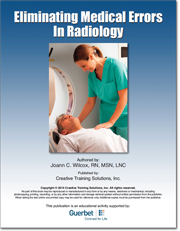
It is essential that all who work in healthcare, particularly those who provide care and services to hospitalized patients, become actively involved in the identification and reporting of errors and in the development of approaches and solutions to avoid the commission of medical errors. The magnitude and the impact of these medical errors make this a problem for everyone and not one that can be resolved by a committee or a variety of project teams. The responsibility rests with each and every person in the system.
Authors today are openly addressing the issue of accountability in the provision of care to patients and, “most doctors and hospital administrators agree that accountability is a good thing” (Makary, 2012 p. 193). Identifying and reporting of errors is an essential demonstration of accountability. It is also recognized that assuming this accountability and ramifications of identifying and reporting errors takes considerable time that many practitioners do not believe is available to them. Using technology to assist in these processes and depending on all members of the team to help each other achieve this level of accountability can make these behaviors a part of one’s daily practice and belief systems.
Following completion of this program participants should be able to:
-
Provide examples of staff involvement in the commission of medical errors that occur in a Radiology Department.
-
Discuss three to seven factors that contribute to the commission of medical errors in a healthcare facility.
-
Identify steps that should be taken to create and maintain a safe environment in which to provide care to patients.
-
Describe steps that can be taken to provide control over the introduction of process changes, in-services and announcements.
-
Define the effect of opting-out and the steps that can be taken to eliminate this practice.
-
Discuss the importance and requirements surrounding the practice of providing information each time the care of a patient is transferred from one provider to another.
-
List practices that support the safe administration of medications, including the five rights of medication administration.
Published by Creative Training Solutions, Inc.
This Publication is an educational activity supported by Guerbet LLC.
|
Infectious Diseases and Infection Control in Radiology
Faculty:
Lori Smith, BSN, MSN
Expiration Date: March 31, 2026
CE Credit Hours:
3.0
Tuition:
No Charge

All Infectious diseases acquired within the healthcare system are a serious and at times fatal problem facing healthcare providers and patients. Due to increases in antibiotic-resistance infections and Covid-19, it is essential that healthcare personnel understand how pathogens are transmitted and ways to prevent infection. Studies have confirmed the presence of infectious bacteria on equipment within the radiology suite and solidified the importance of proper decontamination. One study found a contaminated surface bore of the MRI unit to be positive for the presence of MRSA. Another study evaluating contamination of radiographic markers found that 92% of these devices were contaminated.
When discussing COVID-19 specifically, it has been discussed within recent literature that radiologic technologists who perform CT scans are at an increased risk of exposure to COVID-19. This also applies to radiology department staff performing other types of radiologic tests. Becoming familiar with the procedures set in place is essential in protecting radiologic technologists and those working with patients in the radiology setting from exposure to COVID-19 and other infectious diseases in all areas of radiology.
Following completion of this program participants should be able to:
-
Understand and discuss the types of infectious diseases
-
Describe drug resistance
-
Discuss the inappropriate use of antibiotics and its effect on infections
-
Differentiate between gram positive versus gram negative bacteria
-
List gram-positive and gram-negative bacteria
-
Describe the characteristics of hospitalized patients that contribute to transmission of infectious diseases
-
Define the guidelines for effective hand-hygiene in healthcare settings
-
Describe types of isolation precautions
-
Discuss how to prevent infectious diseases in radiology
-
Discuss how to properly transport a patient within the healthcare facility
-
Understand and discuss aseptic technique in interventional radiology
|
Joint Commission Medication Management Standards In Radiology - 4th Edition
Faculty:
Joann C. Wilcox, RN, MSN, LNC
Expiration Date: April 30, 2026
CE Credit Hours:
3.5
Tuition:
No Charge
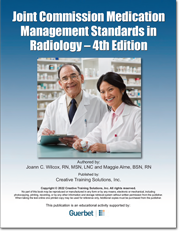
According to the World Health Organization, “Medication errors are a leading cause of injury and avoidable harm in health care systems: globally, the cost associated with medication errors has been estimated at $42 billion annually.”21
The Pennsylvania State Advisory Board says, “An estimated 300 million radiologic procedures are conducted annually in the United States. In cardiac catheterization laboratories, radiology, and other diagnostic departments, medications such as contrast media are administered, rates are adjusted for intravenous (IV) fluids, and IV access lines are flushed. In addition to specific medications that are used in radiology, high-alert medications such as IV sedatives, vasopressors, and blood coagulation modifiers are given in this setting. Nearly 1,000 event reports submitted to the Pennsylvania Patient Safety Authority specifically mentioned medication errors that occurred in care areas providing radiologic serviced. Contrast agents and radiopharmaceutical products were cited in 25% of all medication error report.”47
Following completion of this program participants should be able to:
-
Describe the rationale for the inclusion of imaging services in the organizational medication management plan.
-
Discuss the role of the Joint Commission Medication Management Standards in initiating the changes in the management of medication processes in the imaging departments/services.
-
Identify what patient information is needed to prescribe and administer medications safely.
-
Describe the changes in procedures related to the identification of contrast media and contrast agents as medications.
-
Discuss the appropriate method of securing medications prepared for use during an imaging procedure.
Published by Creative Training Solutions, Inc.
This Publication is an educational activity supported by Guerbet LLC.
|
Managing Patients Undergoing MRI with Gadolinium Contrast Media
Faculty:
Donna Roberts, MD, MS
Expiration Date: February 28, 2026
CE Credit Hours:
1.0
Tuition:
No Charge
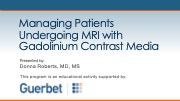
Magnetic resonance imaging (MRI) with gadolinium-based contrast agents (GBCAs) plays a critical role in the diagnosis, evaluation, and follow-up of many CNS disorders. However, as with all drugs, the risks versus benefits must be assessed prior to each use. GBCAs are widely used and have shown a very good safety profile. Although rare, acute hypersensitivity reactions, a condition known as nephrogenic systemic fibrosis in patients with abnormal renal function, and more recently the long-term retention of gadolinium in the body has been associated with GBCA use.
Donna Roberts, MD, MS, discusses the current landscape of GBCA usage in patients with CNS disorders. In addition, the webinar will review the current practice guidelines and future directs for maximizing the clinical benefits of GBCAs while reducing the exposure of patients to GBCAs.
Upon completion the participants will be better able to:
1. Discuss clinical indications for the appropriate use of MRI contrast agents.
2. Discuss considerations for selecting appropriate MRI contrast agents for specific patient populations including stability, efficacy, and patient factors.
3. Describe the risks versus benefits associated with MRI contrast agent usage.
4. Review recent updates to regulatory guidelines concerning MRI contrast agent usage.
Approved by the AHRA for Category A continuing education credit
This webinar is an educational activity sponsored by Guerbet, LLC.
|
MRI Accidents & Preventions: Regulation & Accreditation
Faculty:
Tobias Gilk, M.Arch., MRSO, MRSE
Expiration Date: March 31, 2027
CE Credit Hours:
1.0
Tuition:
No Charge

Despite the “safe imaging option” reputation, when it comes to MRI there are risks that need to be considered in the safety regulation and accreditation standards. Unlike ionizing radiology modalities, such as X-ray, CT, and fluoroscopy, MRI uses powerful magnetic fields and radio waves to produce detailed images of internal body tissues and structures. While MRI is generally considered safe, there are still risks associated with the use of this technology. To address these potential risks, safety regulations and accreditation standards for MRI must be carefully designed and implemented to respond to the safety concerns that are peculiar to MRI. Healthcare providers also need to have access to training and education on MRI accidents and safe practices.
This informative session will shed light on the gaps that exist in MRI safety regulation and accreditation, as compared to ionizing radiology. Participants will learn about the emergent risks associated with MRI and the preventative measures that can be taken. Additionally, Toby will also provide a scorecard of how well accreditation meets its promise of assuring safety when it comes to MRI. Participants will leave, equipped with valuable insights crucial to ensuring maximum safety in MRI practices.
Educational Objectives:
At the completion of this activity, participants should be able to:
-
Explain the long-term trajectory of MRI safety and MRI accidents.
-
Identify a number of existing MRI safety best practices that are profoundly effective at preventing MRI injury.
-
Quantify how many of the injury-preventing best practices are minimum required elements for hospital and MRI accreditation programs.
|
MRI Contrast Agents and Relaxivity: The Physics Behind the Injection
Faculty:
Jeffrey H Maki, MD, PhD
Expiration Date: February 28, 2026
CE Credit Hours:
1.0
Tuition:
No Charge
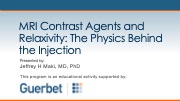
Gadolinium based contrast agents are vital to many clinical applications of MR imaging and contribute greatly to MRI’s powerful diagnostic abilities. As physicians who prescribe, or technologists who administer these contrast agents, it is important to have a good understanding of how they work, and what the differences are between various formulations or “brands”. Gadolinium is a highly toxic heavy metal and is only rendered safe for human administration by tightly binding it to a molecular structure called a chelate. Different gadolinium formulations are characterized by different chelates. The structure of this chelate dictates everything about the agent, from its biodistribution, to its safety profile to how well it does its job of increasing image contrast to highlight different forms of pathology.
Join Jeffrey H Maki, MD, PhD, who discusses the basics of MR relaxation times and how these impact image formation, the mechanism by which MR contrast agents work to relax protons, the different ways the structure of the chelate can be designed to improve this relaxivity and the potential of increased relaxivity contrast agents to impact clinical MR imaging.
At the end of this dynamic discussion, attendees will have a much better understanding of the changing landscape of gadolinium-based contrast agents and be better equipped to most effectively choose and use the most appropriate agent for their patient’s needs.
After attending this webinar the participants will be better able to:
1. Explain the relationship between MR relaxation times and contrast agent relaxivity.
2. Describe what a chelate is and why it is important.
3. Discuss two ways a chelate can be constructed to increase relaxivity.
4. Rank the relaxivities and dosing of the currently available gadolinium contrast agents2.
This webinar is an educational activity sponsored by Guerbet, LLC.
|
MRI Risk Assessment of Implants & Foreign Bodies
Faculty:
Tobias Gilk, M.Arch., MRSO, MRSE
Expiration Date: January 1, 2026
CE Credit Hours:
1.0
Tuition:
No Charge

Apart from no-show patients, clearing patients with implants, medical devices, or foreign bodies is one of the most time-consuming and delay-producing aspects of MRI care. In this presentation Toby Gilk will walk through the various legal duties and limitations relative to authorizing patients with foreign bodies to proceed with an MRI exam, with examples of both appropriate and inappropriate guiding policies.
Next, Mr. Gilk will walk you through ‘untangling’ the risks of scanning patients with devices, reducing one unsolvable mess into identifiable separate risks associated with the three different electromagnetic fields of the MRI: Static Magnetic Field; Time-Varying Gradients; and Radiofrequency Magnetic Fields. Finally, he’ll provide you with a simplified risk-assessment tool that can help evaluate potential risks of harm for every possible implant, device, shrapnel or foreign body.
After attending this webinar the participants will be better able to:
-
Describe the duties of MRI technologists and radiologists relative to clearing patients in whom there are complications / contraindications.
-
Articulate generally the legal boundaries related to patient clearance, risk and benefit assessments, and exam authorization.
-
List the three MRI electromagnetic fields and the hazards each is responsible for.
-
Utilize a sparse risk-assessment tool to make quick evaluations of potential risks for individual patients / individual studies.
|
MRI Scanning at Low Field Strengths
Faculty:
Matt Rederer, MBA RT(R)(MR)(CT
Expiration Date: March 31, 2028
CE Credit Hours:
1.0
Tuition:
No Charge

With advancements making low-field MRI more accessible, low field scanning could become more widespread in imaging. It offers many advantages over high field MRI. With the help of advanced tools, overcoming challenges with low field scanning are possible. Low-field scanners generally pose less risk of heating from radiofrequency pulses and interactions with metallic implants, making it a great alternative to high field scanning. However, MRI safety is something to consider when performing low field imaging. It is not suitable for all examinations and careful patient screening is crucial.
Join Matt Rederer, MBA, RT(R)(MR)(CT)ARRT MRSO MRSE (MRSC) ARMRIT, for a discussion about the advantages and disadvantages of low‐field MRI scanners and safety protocols. The discussion will explore how low-field MRI can enhance diagnostic capabilities, especially in settings with limited resources, and expand accessibility to advanced imaging solutions. You will learn about the latest innovations in AI that are optimizing image quality and scan efficiency at lower field strengths. After participating in this session, you will be better equipped with the knowledge and practical strategies to maximize the potential of low-field MRI.
After attending this webinar the participants will be better able to:
1. Discuss the need for low field imaging.
2. List the benefits and disadvantages.
3. Explain the MRI safety element to low field imaging.
This webinar is an educational activity sponsored by Guerbet, LLC.
|
Neuro MRI with Gadopiclenol
Faculty:
Pareen Mehta, MD
Expiration Date: October 31, 2027
CE Credit Hours:
1.0
Tuition:
No Charge

While GBCAs are essential to performing neuro MR imaging, guidance from the US Food and Drug Administration (FDA) and the American College of Radiology (ACR) includes the recommendation of limiting a patient's gadolinium exposure
One technique for reducing gadolinium exposure is to use a high-relaxivity gadolinium-based contrast agent (GBCA) that can be administered at a lower dose than a conventional GBCA without deteriorating image quality. Gadopiclenol, recently received FDA approval and is a high-relaxivity GBCA, designed to generate high-quality images at half the conventional dose of other GBCAs
This educational program provides the clinical rationale for adopting the use of Gadopiclenol for neuro MRI and includes practice considerations for changing from one GBCA to another.
Through case study reviews, Pareen Mehta, MD, will share clinical insights into achieving optimal image quality using a lower administered gadolinium dose when performing neuro MRI.
Educational Objectives:
At the completion of this activity, participants should be able to:
-
Understand and employ the clinical indications for neuro MRI using gadopiclenol.
-
Apply clinical considerations for lower neuro MRI gadolinium dosing protocols as compared to other GBCAs in neuroradiology.
-
Utilize neuro MR imaging protocols using gadopiclenol to achieve optimal image quality and diagnostic confidence.
This program is an educational activity sponsored by Guerbet, LLC.
|
Next Generation MRI Contrast Agents: Application to Clinical Management and Workflow
Faculty:
Ari D Goldberg, MD, PhD
Expiration Date: March 31, 2027
CE Credit Hours:
1.0
Tuition:
No Charge
New MRI contrast agents continue to be developed, with a focus on continued improvements in stability and safety, as well as maximization of image clarity. These distinctions rest in the molecular structure of the particular gadolinium-based contrast agent. Understanding the relative safety and efficacy of these agents is important in the radiologic management of patients.
During this program, we’ll look closely at novel advances related to MRI contrast safety and management; understanding the risks associated with various agents as well as their efficacy
Educational Objectives:
At the completion of this activity, participants should be able to:
-
Identify the different Gadolinium-based contrast agent classifications.
-
Explain how Gadolinium-based contrast agent stability and safety is evaluated.
-
Describe the concept of gadolinium-based contrast agent "relaxivity".
|
Opportunities Beyond R.T. - Career Pathway Enhancement
Faculty:
Jacqueline K. Peccerillo, R.T. (R)(CT)(BD)(PET)
Expiration Date: January 1, 2026
CE Credit Hours:
1.0
Tuition:
No Charge

Becoming a radiologic technologist (R.T.) is an exciting step in an individual’s career pathway. But, what happens afterwards? Radiologic technology extends beyond diagnostic imaging and includes clinical application specialists, educators, PACS administrators, RIS specialists, medical device representatives, researchers and much more. In training, student radiographers learn about the various modalities beyond general radiography like magnetic resonance imaging, computed tomography , mammography, and bone densitometry. Once officially working as an R.T. in the clinical setting, with exposure to the above modalities, R.T.s may begin to question what they want to do next and seek opportunities for professional growth.
Health care is an interdisciplinary field, and R.T.s are exposed to a wealth of alternative modalities and employment opportunities. Which ones should you choose and how do you move into a new role? By researching the current job market, R.T.s can analyze trending opportunities and profitable positions. After identifying opportunities, a self-assessment must be performed to determine goals, strengths, and weaknesses.
In this practical and engaging webinar, Professor Jacqueline Peccerillo, R.T. (R)(CT)(BD)(PET), will share actionable strategies to uncover opportunities for professional growth and perform self-assessments to identify fitting opportunities. Professor Peccerillo will also share vignettes describing the journeys that other R.T.s have taken to reach their goals to help attendees take the next steps towards the wisest and most fitting career pathway enhancements.
After attending this webinar the participants will be better able to:
-
Evaluate employment trends relative to the radiologic technologist profession.
-
Establish SMART goals for career enhancement.
-
Appraise personal strengths and weaknesses.
-
Create a plan to achieve career goals.
|
Pediatric MRI with Gadopiclenol
Faculty:
Azam Eghbal, MD
Expiration Date: October 31, 2027
CE Credit Hours:
1.0
Tuition:
No Charge
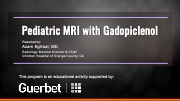
While gadolinium-based contrast agents (GBCAs) are essential to performing MR imaging, guidance from the US Food and Drug Administration (FDA) and the American College of Radiology (ACR) includes the recommendation of limiting a patient's gadolinium exposure. One technique for reducing gadolinium exposure is to use a high- relaxivity gadolinium-based contrast agent (GBCA) that can be administered at a lower dose than a conventional GBCA without deteriorating image quality. Gadopiclenol recently approved by the FDA is a high-relaxivity GBCA, designed to reveal high-quality images at half the conventional dose of other GBCAs.
This educational program provides the clinical rationale for adopting the use of Gadopiclenol for pediatric MRI.
Through case study reviews, Azam Eghbal, MD, will share clinical insights to achieve optimal image quality using a lower administered gadolinium dose when performing pediatric MRI. A focus on the selection and use of a high relaxivity, lower dose GBCA in vulnerable patients, receiving multiple MR contrast injections, will be supported by clinical evidence and imaging protocols. Audience participation will be encouraged during the Q & A session following the presentation.
Educational Objectives:
At the completion of this activity, participants should be able to:
-
Explain the properties that distinguish gadopiclenol from other GBCAs.
-
Apply clinical considerations for lower gadolinium dosing options using gadopiclenol for pediatric MRI.
-
Implement gadopiclenol MR imaging protocols to achieve optimal imaging and diagnostic confidence in pediatric MRI.
-
Employ the use of gadopiclenol in vulnerable patient populations who may experience repeat, lifetime dosing and scanning.
This program is an educational activity sponsored by Guerbet, LLC.
|
Providing Safe Patient Care by Preventing Healthcare Acquired Conditions and Serious Reportable Events - 2nd Edition
Faculty:
Joann C. Wilcox, RN, MSN, LNC
Expiration Date: December 31, 2025
CE Credit Hours:
3.5
Tuition:
No Charge
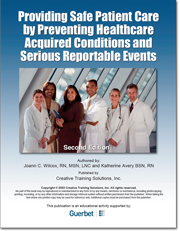
Many studies have demonstrated that one of the major causes of the increase in healthcare costs is related to unexpected treatment needed as the result of a medical error, a Serious Reportable Events, and/or a healthcare acquired condition. While many insurers, including the Centers for Medicare and Medicaid, have stopped reimbursing hospitals for care and treatment needed following the commission of specifically defined medical errors, those costs still remain part of patient care delivery, leading to a reduction in funding available for other components of healthcare.
All who are involved in the delivery of patient care should be knowledgeable of, and fully implement infection-control programs, as well as any initiative put in place to avoid Never-Events/Serious Reportable Events, from occurring in the healthcare setting. The transformation needs to occur in the culture of the provision of healthcare to include a clear expectation of the individual responsibility of EACH person who is providing care.
This program will educate the healthcare provider on ways they can make a difference in the commitment of errors and reportable events during patient care.
Following completion of this program participants should be able to:
-
Identify the major events in history leading to the Deficit Reduction Act of 2005 addressing costs of never-events to the healthcare system
-
Describe the basis for the transformation of inpatient care as this relates to the elimination of Serious Reportable Events
-
Discuss the needed cultural changes to successfully implement the transformation of inpatient care to the level of safety desired
-
Discuss critical aspects of infection control as they relate to the elimination of hospital-acquired infections
-
List the benefits of patient-centered care as it relates to the prevention of medical errors and Serious Reportable Events
-
Discuss the impact of identifying Serious Reportable Events and the potential for litigation if a Serious Reportable Event occurs
-
Discuss the accountability factor as it relates to Serious Reportable Events
-
Describe effective approaches to care delivery aimed at preventing Serious Reportable Event
-
Discuss the importance of evolving infection prevention in the ever-changing health care environment
Published by Creative Training Solutions, Inc.
This Publication is an educational activity supported by Guerbet LLC.
|
Radiation and Radiology Safety in the Delivery of Patient Care - 2nd Edition
Faculty:
Joann C. Wilcox, RN, MSN, LNC
Expiration Date: May 31, 2027
CE Credit Hours:
4.0
Tuition:
No Charge

The use of radiation is a critical component in the delivery of healthcare today. There is very little medical care provided that does not include some level of radiography to get a picture of what is being described or felt upon examination. The practice of Radiology is complex, has multiple and differing tests, examinations, and treatments. This complexity requires those who are involved in any aspect of the delivery of this care to have the knowledge needed to ensure the patient is safe and cared for if a medical error occurs.
This booklet describes the care and safety of the patient receiving non-interventional radiographic procedures and additional aspects of patient care provided by the Radiology staff. Patient safety is defined as the prevention of harm and is a “fundamental right of all Americans” (Kizer & Blum, nd). Achieving this safe care is complex, and there are many obstacles in the way of accomplishing this level of care.
Following completion of this program participants should be able to:
-
Pinpoint steps that should be taken to create and maintain a safe environment in which to provide care to radiology patients.
-
Name the components of a Patient Safety Program.
-
Identify the two major groups of patient’s rights.
-
Describe an example of an error’s classification system.
-
Define Sentinel Event and provide an example of one addressing radiology services.
-
Discuss alternatives to punishing people for making mistakes.
-
Describe a method using an everyday product to improve patient safety.
Published by Creative Training Solutions, Inc.
This Publication is an educational activity supported by Guerbet LLC.
|
Radiation Dosing 2nd Edition
Faculty:
Joann C. Wilcox, RN, MSN, LNC
Expiration Date: March 31, 2026
CE Credit Hours:
3.0
Tuition:
No Charge
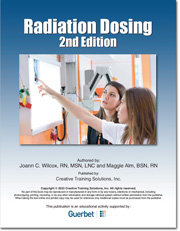
It is generally noted that negative health outcomes are directly related to the amount of radiation to which one is exposed and the length of time of that exposure. While the most common side effect of radiation is thought to be the development of cancerous cells, some additional side effects do occur, and they sometimes develop much faster than cancer. Some of these additional acute health effects are skin burns, weakness, hair loss, and illnesses such as nausea. Other negative health effects of radiation exposure include changes in organ functioning, congenital malformation, and death.
The most significant medical exposure for most comes in the form of diagnostic x-rays or tests that use forms of ionizing radiation. These tests include conventional x-rays, fluoroscopy, CT/CAT scans, and positron emission tomography (PET).
While no current data demonstrates that a CT, for example, increased the incidence of cancer, the Joint Commission reported that the 74 million CT scans performed in the U.S. in 2017 could cause a projected 29,000 cases of future cancer and 14,500 future deaths due to radiation. However, even without significant data, mainly focused on the relationship between radiation and cancer, there is sufficient experience over the last several years to indicate that radiation exposure carries a risk for cancer over time.
There are actions that organizations can take to minimize radiation exposures. First, staff should be aware of the contributing factors to, and activities that can help eliminate, avoidable radiation exposures.
Following completion of this program participants should be able to:
-
Discuss the brief history of the development of x-rays using ionizing radiation
-
Identify ways in which people are exposed to radiation.
-
Discuss the intent of “As Low as Reasonably Achievable”.
-
Describe the relationship between medication reconciliation and recording of radiation exposures.
-
Define the dilemma that exists with the use of diagnostic radiation.
-
List the negative effects of radiation exposure.
-
Describe the intent of the Joint Commission Sentinel Event 47.
-
Discuss the steps to reduce radiation exposure.
-
Describe the Promoting Interoperability Program and radiology.
-
Discuss Imaging Gently, Imaging Wisely, and Step Lightly.
-
Discuss changes to gonadal shielding.
-
Discuss strategies to address dose optimization.
-
Discuss progress toward radiation dosing standards.
-
Discuss Step Lightly’s recommendations for radiation safety in pediatric interventional radiology.
Published by Creative Training Solutions, Inc.
This Publication is an educational activity supported by Guerbet LLC.
|